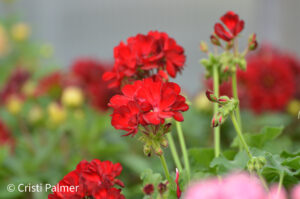
Potted plants like geranium and impatiens are typically grown in the warmer regions of the United States and require shipping to reach northern markets for sale to homeowners. Stresses such as darkness, temperature fluctuations and increased ethylene levels during shipment may accelerate plant senescence when they reach retail benches. Decreases in plant quality characterized by bud and flower drop, leaf yellowing and abscission, and greater susceptibility to stresses such as drought at retail locations are common problems resulting in considerable losses. Development and registration of plant growth regulators (PGR’s) that help overcome shipping stress, and enhance shelf life quality are of great interest to the potted ornamental horticulture industry. At the IR-4 2005 Annual Workshop, evaluating products to enhance shelf quality and display life of potted ornamentals became a high priority project within the herbicide/pgr disciplines.
In 2006 and 2007, ten products representing five different active ingredients were tested for enhanced shelf life in potted ornamental species including potted geranium, impatiens, New Guinea impatiens, poinsettia and tulip. Six active ingredients 1) ABA, 2) 6-BA, 3) GA4+7, 4) 6-BA + GA4 + 7, 5) thidiazuron and 6) s sodium silver thiosulfate were identified as promising products for this research and compared to the standard 1-methylcyclopropene (EthylBloc). Some products were in development (Configure) for use on ornamentals while others (Argylene, MaxCel/Exilis Plus, Fascination/Fresco, NovaGib/Provide, TDZ) have been registered with the EPA for other uses.
The GA4+7 products generally were not phytotoxic to geranium and had some positive effects but increased peduncle length was unacceptable. Products containing 6BA at 100 ppm caused significant injury on geranium which varied by cultivar. Limited testing on New Guinea impatiens and Impatiens walleriana suggests that ABA applications may improve days to wilting on select varieties. GA4+7 treatments to Impatiens walleriana increased flower number but caused stretch in both Impatiens walleriana and New Guinea impatiens. A single experiment involving TDZ treatments at 5 and 10 uM showed promise in improving geranium and poinsettia post harvest life although it delayed flowering in geranium. Limited testing with TDZ and Fascination (6-BA+GA4+7+6-BA) suggest beneficial effects on Tulip sp. Results are not adequate at this time to consider registration of any of the products tested on any of the herbaceous species studied. Further research is merited to identify the underlying cause of phytotoxicity observed, to fine tune rates and to test new treatments becoming available (e.g. S-ABA or Contego).


